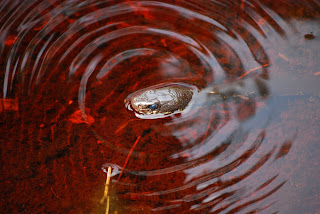23 species of snakes have been recorded in the Sebangau National Park. These vary from the small vine snakes to the largest of all venomous snakes, the King Cobra. There are arboreal snakes that prefer to live in the trees, such as the grey-tailed racer, and other species that spend most of their time on the ground or in the water. Some species have amazing adaptations, such as the Bornean black snake that has a particularly smelly adaptation! When threatened this snake produces an unpleasant smelling substance from glands on the underside of its body.
Speckled-headed vine snake – Camp – Connie Miller – 2015 |
Grey-tailed racer – Camp – Connie Miller – 2015 |
The King Cobra is another one of the amazing snakes that you might be lucky (or unlucky!) enough to find in the Sebangau National Park. These snakes can grow up to 5.5m in length, making them the longest venomous snakes in the world. They can inject enough venom in one bite to kill twenty humans or an elephant! King cobras are the iconic snakes used by snake charmers because of their recognisable hood. However, did you know that they are deaf to most sounds and are in fact attracted by the swaying movement of the charmer’s flute rather than its music?
 |
King Cobra In Water – Sebangau – OuTrop – 2011 |
Pit vipers are a sub-family of snakes that can also be found in the Sebangau National Park forest. Pit vipers are called this because of heat-sensing pit organs that can be found between the eyes and the nostrils on either side of the head. These infrared-detecting sensors allow the snakes to sense the presence of warm-blooded animals nearby. They will often be seen waiting in ambush for one such mammal to pass by so that they can strike!
 |
| Wagler’s Pit Viper – Sebangau – Bron – 2012 |

